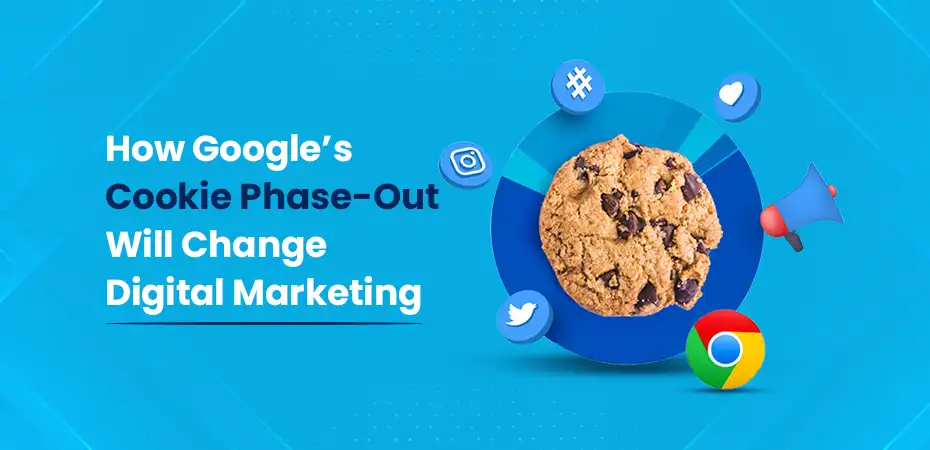How Google’s Cookie Phase-Out Will Change Digital Marketing



Google’s decision to stop using third-party cookies in its Chrome browser by 2025 is a big deal. With Chrome being the most popular browser, this change will affect billions of people and businesses that rely on digital advertising. This blog explains what third-party cookies are, why they’re being phased out, and how marketers can adapt to this major shift.
What Are Third-Party Cookies?
Third-party cookies are small files that websites store on your device. However, these cookies don’t belong to the website you’re visiting. Instead, they come from other companies, often advertisers, that use them to track your behavior across different websites.
Why are they important?
- Tracking behavior: They help companies understand your interests.
- Ad personalization: These cookies allow ads to match your preferences.
- Remarketing: Businesses can show ads to people who visited their site before.
For example, if you look at shoes on one website, third-party cookies might help show you ads for similar shoes on another site.
Why Is Google Blocking Third-Party Cookies in Chrome?
Google’s decision to block third-party cookies in Chrome marks a significant shift in the world of digital advertising and online privacy. Third-party cookies are small pieces of data that websites place on your browser to track your online activities. They allow advertisers to follow users across multiple websites, collect information about their preferences, and deliver targeted ads. While these cookies have been a key part of digital marketing for years, they also raise serious privacy concerns.
One of the main reasons for blocking third-party cookies is growing user demand for better privacy. People are increasingly aware of how their data is being tracked and used. Surveys show that a majority of internet users are concerned about their online privacy and want more control over how their data is collected. By phasing out third-party cookies, Google aims to address these concerns and align Chrome with modern privacy standards.
Another driving factor is the introduction of strict privacy laws like the General Data Protection Regulation (GDPR) in Europe and the California Consumer Privacy Act (CCPA) in the United States. These regulations require businesses to get explicit consent from users before collecting their data, making it harder for companies to rely on third-party cookies. Blocking cookies simplifies compliance with these laws and helps Google maintain its reputation as a privacy-conscious company.
Competitors like Apple and Mozilla have also taken steps to block third-party cookies in their browsers, Safari and Firefox, respectively. By joining this trend, Google ensures that Chrome remains competitive and stays ahead in the market. Chrome’s massive user base—over 3.5 billion people—makes this move especially impactful, as it will reshape digital marketing on a global scale.
Lastly, blocking third-party cookies pushes the advertising industry to innovate. Google is promoting its Privacy Sandbox initiative, which offers new tools for advertisers to target users while respecting their privacy. These tools, such as the Topics API and FLEDGE API, aim to provide effective advertising solutions without compromising user data.
In summary, Google’s decision to block third-party cookies is driven by privacy concerns, legal requirements, competitive pressures, and the need to innovate. This change will transform how businesses track and target users online, making it crucial for marketers to adapt to the new reality.
What Can Marketers Do to Adapt?
Marketers must rethink their strategies to thrive in a world without third-party cookies. While the loss of these cookies poses challenges, it also opens the door to new opportunities for privacy-first marketing. Here are some key steps marketers can take to adapt:
Focus on First-Party Data
First-party data—information collected directly from users through interactions with your website, app, or emails—is more important than ever. This data is more reliable and privacy-compliant because users share it directly with you. To collect first-party data effectively:
- Offer incentives like discounts, exclusive content, or loyalty programs to encourage users to share their information.
- Use engaging tools like surveys, quizzes, or preference centers to gather valuable insights about your audience.
- Ensure transparency by clearly explaining how user data will be used and securing their consent.
Leverage Contextual Advertising
Contextual advertising places ads based on the content of the webpage, not the user’s browsing history. This approach respects user privacy while delivering relevant ads. For example, a sports equipment brand can advertise on a website featuring articles about fitness. Benefits of contextual advertising include:
- No reliance on third-party cookies
- Enhanced brand safety by aligning ads with relevant content
- Improved user experience through non-intrusive targeting
Explore Google’s Privacy Sandbox Tools
Google’s Privacy Sandbox offers alternatives to cookie-based tracking. These tools include:
- Topics API: Targets users based on general interests rather than specific browsing habits.
- FLEDGE API: Enables remarketing campaigns without revealing personal data.
- Attribution Reporting: Helps measure ad performance while maintaining user anonymity.
Marketers should start experimenting with these tools to understand how they can fit into their advertising strategies.
Build Direct Relationships with Publishers
Partnering directly with publishers allows marketers to access high-quality, first-party data and target specific audiences without third-party cookies. Collaborating with trusted publishers also ensures better control over ad placements and brand safety.
Invest in Technology and AI
Advanced technologies like artificial intelligence (AI) can help marketers analyze first-party data and deliver personalized experiences. AI-powered tools can identify user preferences, predict behavior, and optimize ad campaigns without relying on cookies.
Educate Your Team
Finally, marketers must invest in training and education to stay updated on the latest tools and privacy regulations. Understanding the new landscape is essential for building effective, privacy-first marketing strategies.
By embracing these strategies, marketers can turn the challenges of a cookie-less future into opportunities for innovation and growth. The key is to prioritize user privacy while delivering meaningful and engaging experiences.
Exploring Browser-Specific Solutions
Browsers are also offering tools to help users manage cookies and data:
- Chrome: You can view and manage Chrome cookies in settings or use cookie blocking extensions.
- Safari: Allows enabling third-party cookies when necessary but focuses on user privacy.
- Brave: A privacy-first browser that doesn’t sell your data.
Users can check cookies in Chrome, delete individual cookies in Brave, or enable third-party cookies in Safari to customize their browsing experience.
Alternatives to Cookie-Based Tracking
As cookies fade away, here are other ways to track and engage users:
- Facebook Conversions API: Tracks events server-to-server for accurate data.
- Enhanced Conversions: Uses hashed data for privacy-compliant tracking.
- Storage Access API: Balances functionality and privacy by requesting user permission for cookies.
The Role of Third-Party Themes in Chrome
Users have also raised questions about themes and extensions in Chrome. For instance:
- How to allow third-party themes in Chrome 2024: Enable them through Chrome flags settings.
- Why do some third-party themes close my browser: It could be due to compatibility issues or malicious code.
Businesses using themes should ensure they’re compliant with browser policies to avoid disruptions.
Embracing the End of the Cookie Era
The end of third-party cookies is not the end of digital marketing. Instead, it’s an opportunity to build trust with users through transparency and privacy-focused strategies. Companies that adapt to this change by using first-party data, contextual ads, and privacy-first tools will thrive.
Conclusion
The phase-out of third-party cookies in Chrome marks a pivotal shift in digital marketing. To thrive in this new era, businesses must embrace privacy-first strategies, leverage first-party data, and explore innovative solutions to stay connected with their audience.
Need help navigating the cookie-less future? SEO Expert New York is here to guide you. Contact us today to develop tailored, privacy-compliant marketing strategies that drive impactful results and keep your business ahead of the competition!
Frequently Asked Questions (FAQs)
Google’s announcement to phase out third-party cookies signifies a major shift in digital marketing, as these cookies have traditionally been used to track user behavior and serve targeted ads. This change presents both challenges and opportunities for marketers, requiring them to adapt their strategies to maintain effectiveness in a cookie-less environment.
Third-party cookies are small pieces of data stored on a user’s device by websites other than the one they are currently visiting. They are primarily used to track user behavior across multiple sites, enabling advertisers to serve personalized ads based on browsing history. While effective for targeted advertising, their reliance raises privacy concerns among consumers.
The removal of third-party cookies will significantly impact tracking and targeting strategies used by advertisers, making it more challenging to gather user data for personalized marketing. Additionally, regulatory frameworks like GDPR and CCPA influence this change by promoting consumer privacy, which further complicates traditional advertising methods.
Marketers can focus on first-party data collection strategies, which involve gathering information directly from users through interactions on their own platforms. Contextual advertising serves as a viable alternative, allowing ads to be displayed based on the content being consumed rather than user behavior. Building personalized experiences using first-party data and contextual signals is also essential.
Google’s Privacy Sandbox initiative introduces new tools like Google Ads Conversion Linker and Enhanced Conversions as potential replacements for traditional cookie-based tracking methods. These tools aim to maintain effective ad performance while respecting user privacy in a post-cookie landscape.
Forming direct advertising partnerships allows marketers to reach target audiences effectively without relying on third-party cookies. Additionally, exploring subscription models can provide alternative revenue streams for publishers and content creators, adapting to the evolving digital marketing landscape while ensuring compliance with privacy standards.